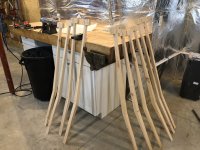- Joined
- Nov 22, 2021
- Messages
- 373
- Reaction score
- 551
I've been on a paddle buying binge. I've ordered four canoe paddles in the last few weeks. That brings my total to around a dozen.
I wanted to make sure I didn't waste money by buying the "wrong" size, so I researched sizing methods.
When you shop for a paddle, the paddle size is the entire length of the paddle.
What you are interested in is the shaft length. Find your correct shaft length and add the blade length to that to get your correct paddle size.
Any method that uses your height should be avoided. I'm over six feet, but I have a short torso. If I picked a paddle based on my height, it would be too long.
For most methods, you need to sit on something like a bench or hard chair. I use a large Igloo cooler. Then measure from the surface, between your legs, to either your nose, eyes or chin and they may ask you to add a certain number of inches to that then look at their chart to see what size paddle you need. My measurement from the cooler to the tip of my nose is 29".
Badger takes a different approach. They use a similar method to that used to size a kayak paddle. Hold the paddle by the grip and the throat and rest it on top of your head. Your elbows should be at, or slightly less, than 90 degrees. But I came up with the same length I did for most of the other methods. I don't know if it would come out that way for most people or I'm unusual.
I came up with 32 to 33 inches for Gray Owl, Badger, Sanborn, and Outdoor Play's chart for the Werner Journey paddle. Werner's website refuses to give sizing recommendations. So about three to four inches over the measurement to my nose is supposed to be the right shaft length for me.
Seat height should fit into the equation. If you have a high seat, you might add to that, if you have an especially low seat, you might subtract from that.
Bending Branches is the only one that wasn't in the 32-33 range. They said I should have a 36" shaft.
I tend to think that Bending Branches method gives a result that's too long, since they differ from everyone else.
For a bent shaft or beavertail, I'd go a couple inches less.
None of this is written in stone. I'm sure there are experienced paddlers that go longer or shorter. There is no absolute right length.
I wanted to make sure I didn't waste money by buying the "wrong" size, so I researched sizing methods.
When you shop for a paddle, the paddle size is the entire length of the paddle.
What you are interested in is the shaft length. Find your correct shaft length and add the blade length to that to get your correct paddle size.
Any method that uses your height should be avoided. I'm over six feet, but I have a short torso. If I picked a paddle based on my height, it would be too long.
For most methods, you need to sit on something like a bench or hard chair. I use a large Igloo cooler. Then measure from the surface, between your legs, to either your nose, eyes or chin and they may ask you to add a certain number of inches to that then look at their chart to see what size paddle you need. My measurement from the cooler to the tip of my nose is 29".
Badger takes a different approach. They use a similar method to that used to size a kayak paddle. Hold the paddle by the grip and the throat and rest it on top of your head. Your elbows should be at, or slightly less, than 90 degrees. But I came up with the same length I did for most of the other methods. I don't know if it would come out that way for most people or I'm unusual.
I came up with 32 to 33 inches for Gray Owl, Badger, Sanborn, and Outdoor Play's chart for the Werner Journey paddle. Werner's website refuses to give sizing recommendations. So about three to four inches over the measurement to my nose is supposed to be the right shaft length for me.
Seat height should fit into the equation. If you have a high seat, you might add to that, if you have an especially low seat, you might subtract from that.
Bending Branches is the only one that wasn't in the 32-33 range. They said I should have a 36" shaft.
I tend to think that Bending Branches method gives a result that's too long, since they differ from everyone else.
For a bent shaft or beavertail, I'd go a couple inches less.
None of this is written in stone. I'm sure there are experienced paddlers that go longer or shorter. There is no absolute right length.
Last edited:

